First signs of Spring
This week: Supermarket temptation; First signs of Spring; 2021 Approaches; Bulbs;
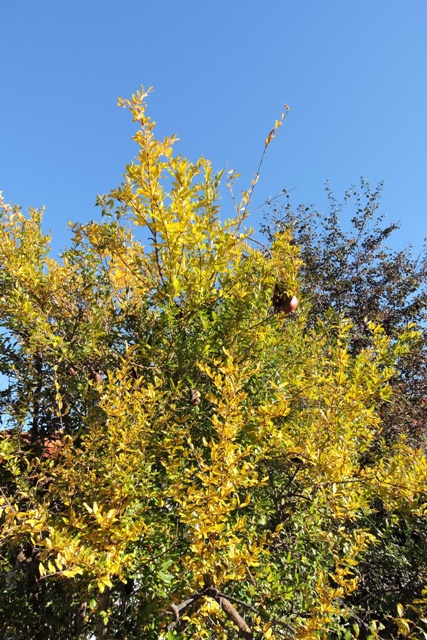
I have had the wood stove going every day this week. The good things about cutting up firewood by hand is that it warms you twice. Once when you cut it, and again when you burn it!
It hasn’t been especially cold. It has just been the normal seasonal chill that comes once the sun has sunk below the hills to the south, just after lunch.
There has been a cold Bura blowing at times as well. So I’ve retreated into my newly draught proof greenhouse to work.
Supermarket temptation
You know what is it like in the supermarket. The closer you get to the checkout, the more tempting the displays. There is even a term for the marketing of these items, they are the “impulse purchase displays”.
I know not to buy anything from the displays next to the checkouts, but there are exceptions…
I called in at Konzum on Sunday morning and close to the checkouts there was a display of Poinsettia. These are the so called Christmas flowers.
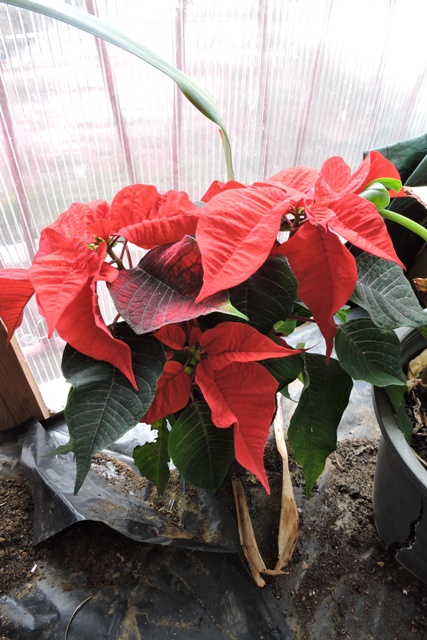
Only they are not flowers. The lovely crimson coloured inflorescence are in fact bracts.
These are specialised leaves produced by a number of different plant species, often brightly coloured and designed to attract pollinators. The actual flowers are deep in the centre of each stem and are insignificant.
Where I lived in Spain, they grew wild by the side of the road often growing to two or three meters tall. So as a self seeded “weed”, they should not be too difficult to grow, should they?
Well I’ve not had a great deal of success. Over the past few years, I’ve bought a plant most Christmases, but by mid-January the thing is dying or has died. Trying to get one to grow on in its pot, let alone outside, has been an abject failure.
This year I’m determined to succeed, so I’ve been reading up on what they need. Primarily it is a stable temperature, followed by definite day and night period and not too much water. That means no artificial room lighting, nor abrupt changes in temperature.
During some cold afternoons this week, I have had a good clear up in the greenhouse. I’ve installed my Poinsettia in the heated propagator, somewhere that the temperature is controlled by thermostat.
The propagator isn’t being heated for raising seeds just yet so I lowered the temperature to +16ºC. I’m hoping that my different approach this year will pay off.
I’d also like to admit that I also bought a packet of Božićna pšenica, or Christmas Wheat seeds. They were on the stand next to the checkout too!

These are a traditional planting that you make in December on 4th of December, the Feast of St, Barbara. This is so that there can be greenery on the table on Christmas day. Fresh, green growth is said to symbolise the renewal of spring, celebrated in the bleak midwinter.
I seldom buy chocolate, but one of my temptations is plants and seeds.
First signs of Spring
As we head into the dark days of the northern mid winter – and the further north you are , the darker the days, it is comforting to remember that it will soon be spring.
Even a month in advance of the northern Winter Solstice, things are stirring between your feet.
Hopefully in the spring there will be supplies of the COVID vaccine available. Vaccines should start to return the world to a more normal state, even if life will never go back to being exactly as it was pre pandemic.
There is only one Mediterranean climate and you find it in parts of the Mediterranean basin. But not everywhere across the countries which surround the sea enjoy the climate.
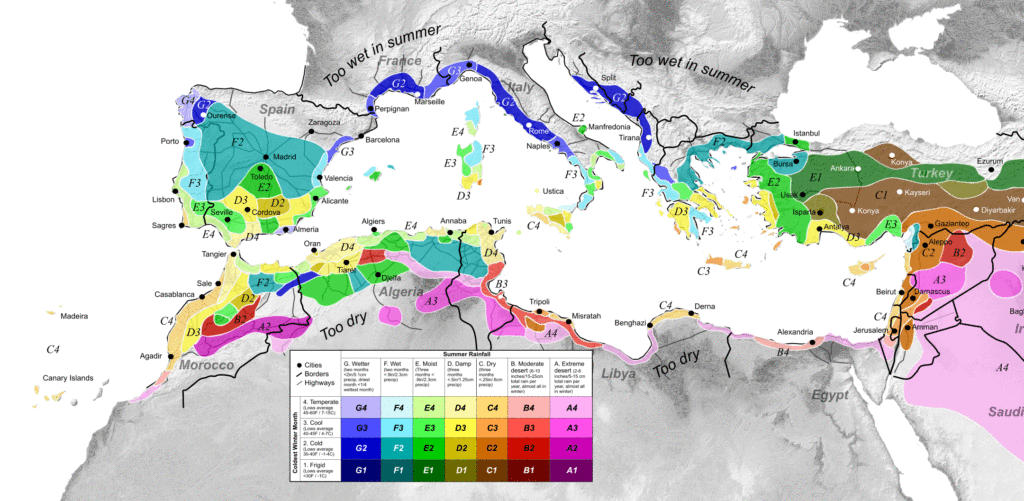
There are then the “other” Mediterranean type climates. These are places which enjoy similar climatic conditions: similar precipitation patterns; similar heating and cooling; similar temperature ranges.
The Mediterranean climate is generally described as a “Dry summer climate”. ‘Summer dry’ can be found to the immediate north and east of Cape Town, S. Africa; the areas surrounding Perth and Adelaide in Western Australia; the Pacific coast of Chile; the California coast from Baja California as far north as Eureka; and the Middle East from Turkey to the Stans.
The Pacific Bulb Society has a very useful webpage with multiple charts. There are based on data gathered before the current cycle of global warming. The charts give a good indication of the various conditions found in “summer dry” climates, in the different parts of the world where they are found.
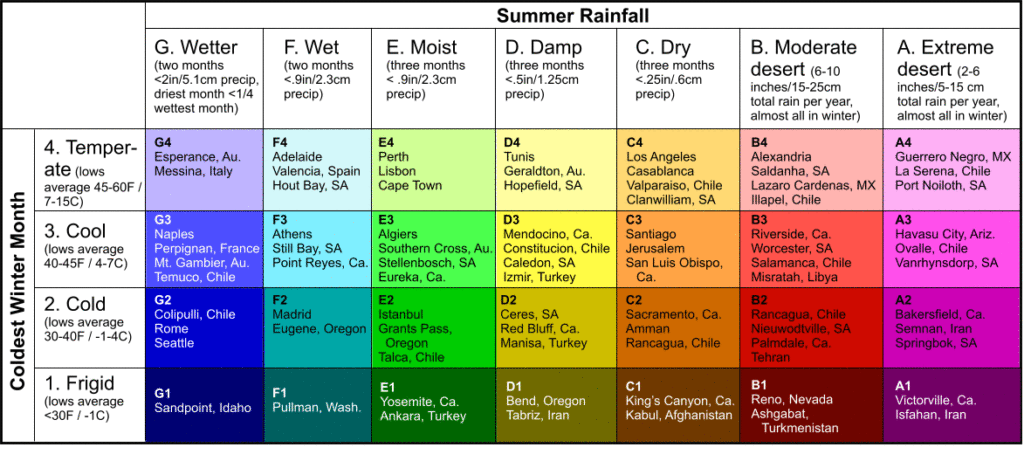
Dol is in currently classed as being in G3, based on our coolest month, which is January. As climate change continues, we may well move up into G2.
As the rainfall pattern changes, Dol may even move from band G to band F. Or conceivably even band E, based on the recent work I have been doing on falling seasonal averages.
What this means in practice is that this week when I was weeding around the base of a Mandarin tree, I found that the spring bulbs are already coming through.
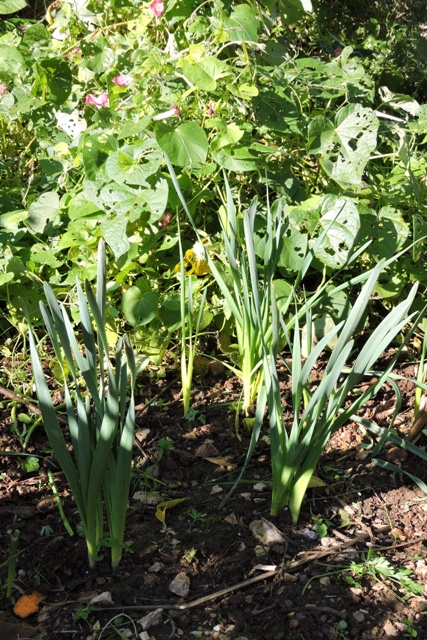
These are Narcissi tazetta.
Last year I had flower buds visible on 14th December and they were in flower on 23rd December. This week they have their first buds.
This is the earliest date since I started my Phenology records, by some weeks! It may be that this year I am being more observant and spotted the flower bud as soon as it has appeared. Previously I may only have noticed it when it was much taller and more obvious.
I will be interested to see what date the bud bursts into flower.

It was warm in the sun, even though half the orchard is now in perpetual shade.
All this means that although we are a month away from the winter solstice, the first signs of spring are already visible.
2021 Approaches
With just over five weeks to January 1st, together with cool afternoons when the sun has dropped below the hills to the south, I’ve been getting ready for new year.
It’s really just computer housekeeping. Things like making sure I have new folders for documents and photographs, ready for the 2021. Having everything in folders does make it easier to find files later.
But I’ve also been making sure that anything which needs some work doing to it, has been updated. For example the spreadsheets I use to record data, have all their formulae’s updated and ready.
Taking the hint from my previous comment about the early appearance of the Narcissi flower buds, I’ve updated my list of dates for the indicator species.
I’ve taken the opportunity to change the format slightly to. So as well as recording the date I see or hear something, I have now added in a function to give me an average date for when the event has been seen/heard. This is a little bit more information about whether things are being observed earlier or later than previously.
The sad thing is that there is nothing available for me on the island or even close to it, to check my dates against.
I’m also very aware that because my Dol house is in a Thermal Belt. This is an area generally warmer than surrounding locations. Because of this I probably couldn’t really make any meaningful local comparisons anyway.
The value in all this will be in the future. When my comparisons go back a lot further, an interested observer can really then see the effects of climate change.
Bulbs
I like bulbs because they tend to be “plant and forget” horticulture.
Once the right location is selected and they are planted, you generally need only to keep them weed free and suddenly up they pop and flower.
They generally do not need pruning. Maintenance is perhaps just taking the dead flower heads off, but that apart they are maintenance free.
I have had some failures though. I cannot seem to get Fritillaria to grow. However other tropical bulbs, when planted carefully, seem to be thriving.
This week I noticed some pink flowers peeping through the remaining leaves on my Spider lilies.
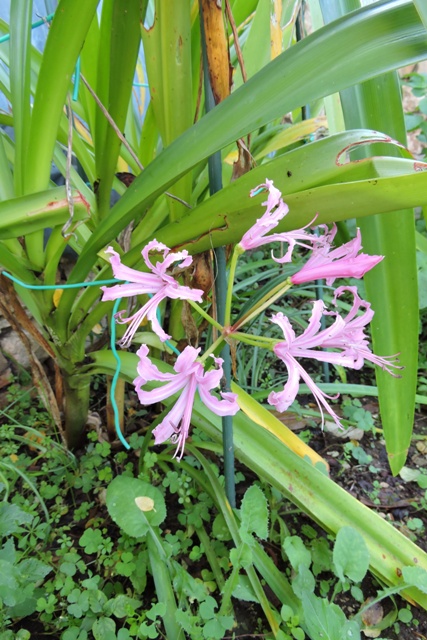
These are Nerine bowdenii which originate in the Cape Province of South Africa.
There are still a number of pollinating insects flying, especially the bees. This week my Loquat tree has been covered in cream flowers. On sunny days this week, the bees have been all over the flowers.
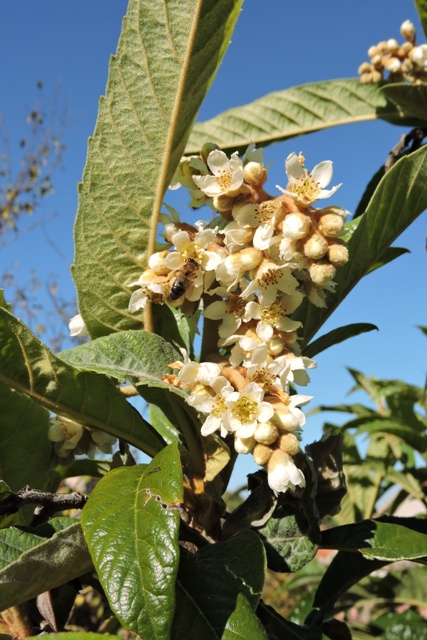
There will be ripe oval sweet orange fruit on the tree by late March. Once formed, the fruits resemble plums, that can be picked and used in pies and compotes.
One of the longest lasting flowers I have are Morning Glory, or Ipomoea. I leave them to twine up through a couple of old citrus trees and they will flower until the winter cold of early January arrives.
They are really a weed, of the convolvulus family. But providing you pull up the many seedings which grow from the widely scattered seeds, you can have a nice display of autumn colour.
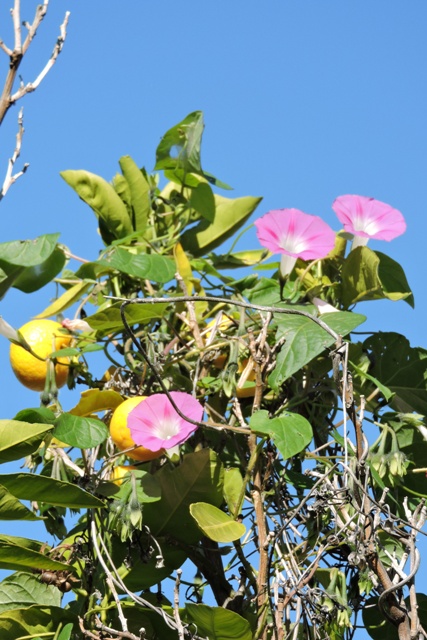
The late autumn sunshine has encouraged the flowers on my lemon trees to burst. Although there are large number of buds around the flower, most will drop off. This leaves just one or two fruit to develop on each spur.
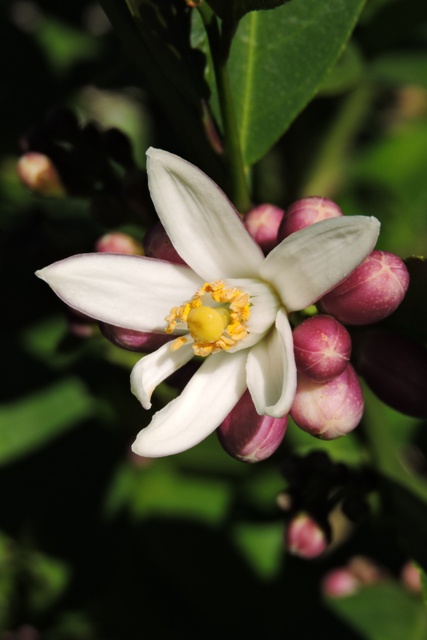
It’s that time of the week again!
Late on Saturday afternoon, the sun is setting, illuminating the island of Brač to the north as I look out of my study window.
I’m already thinking about the jobs I need to do next week.
But right now, I need to go and put another log in the wood stove, to keep the central heating water hot. NCG
2 Responses
John Bailey
This has cheered me up Norman. The early signs of spring appearing. Good news on the vaccine front the as well.
Andy Robinson
Interesting and informative as usual. Funnily enough Julie bought a poinsettia today at The Range…. We won’t be planting it though!